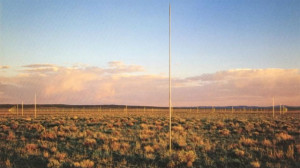The late artist and musician Walter De Maria’s The Lightning Field (1977) is an immersive Land Art sculpture composed of four hundred stainless steel rods gridded out in the high desert of western New Mexico. The artist’s parameters for viewing the work are explicit, stewarded by the original commissioner, the Dia Art Foundation. Viewing is roughly a twenty-four hour experience. Visitors lodge in a former homesteader’s cabin and dine on prepared offerings. The number of visitors is capped at six; if there are fewer in your party, your reservation will most assuredly be bundled with strangers. Reservations open March 1st for visits seven days a week May through October. July and August are “lightning season” and these reservations cost a premium. Though comparatively expensive when considering that many art experiences are free, a visit to The Lightning Field is on par with the cost of staying in a decent hotel, seeing a show and dining out a few times, except, of course, for the fact that you cook your own meals with strangers in a very rustic splintery-spidery log cabin and hope for lightning to strike the property.
I had reservations in mid-August last year. The drive from Albuquerque — some two hours, no public transportation — wends through the breathtaking landscape of El Malpais National Monument, the result of a volcanic eruption 3000 years ago. On one side of the road massive lava flows are frozen in time, on the other Basalt columns extend up to the rolling clouds overhead. Some of the oldest Douglas Fir trees on the planet live in the monument, which was used as a bombing range to test pilots during World War II. El Malpais’ surreal lava fields and ghostly La Ventana Arch is, without a doubt, one of the most incredible landscapes I’ve ever seen.

Visitors meet at Dia’s office in the small town of Quemado (pop. 906), a short distance beyond El Malpais, and are instructed to check in at the white two-story building on the main street. It is, in fact, the only two-story building on a quiet stretch of road featuring fewer than a dozen buildings, including a cafe, a hardware shop, and what appeared to be a perpetually closed gallery, its entrance graced with dozens of sun bleached antlers arranged in a decorative arch. When I inquired about buying wine at the country store, the young woman at the counter harrumphed and jutted her chin eastward. Apparently the only gas station in this otherwise dry community recently began selling cheap wine, undoubtedly to the relief of a few townsfolk, many art tourists and this writer in particular. I visited a few of the other open businesses and chatted with bemused locals. None had ever visited The Lightning Field. (Writer and curator Lucy Lippard recently remarked, “Land Art is for city people.” Nowhere does this seem more apropos than Quemado.) A young man in the hardware store told me he was sure lightning hitting the rods would scare the crap out of him. I laughed and wondered if I felt the same way.
A Swiss and a French couple on a marathon Land Art tour joined my husband and me as we waited at the Dia office. Robert Weathers, one of the original builders who worked with De Maria and the caretaker to this day, met our group to shuttle us out to the field. We chatted a little as we drove, but mostly we all took in the landscape, scanning the horizon and waiting to see glints of metal. When we arrived at mid-afternoon, the sculpture was barely visible in the field. As the day wore on dramatic changes in visibility arose from imperceptible shifts in sunlight, and reflections formed prismatic patterns across the distance of the sculpture. At various times different guests would walk out to the field and gradually disappear into the distance, only to reemerge on the horizon as they returned an hour or two later.

My perception of the work was shaped by the details I found walking between the rods in the field as much as it was by looking at the sculpture from the shaded porch of the cabin. I had never walked in the desert and I was entranced. I saw nature I hadn’t seen before, including three different pre-historic looking beetles, as brilliant as rubies and sapphires, industrious red ants scurrying over hills that rivaled the pyramids, and elephantine piles of sun baked shit from wandering cows, a marvel unto themselves.


